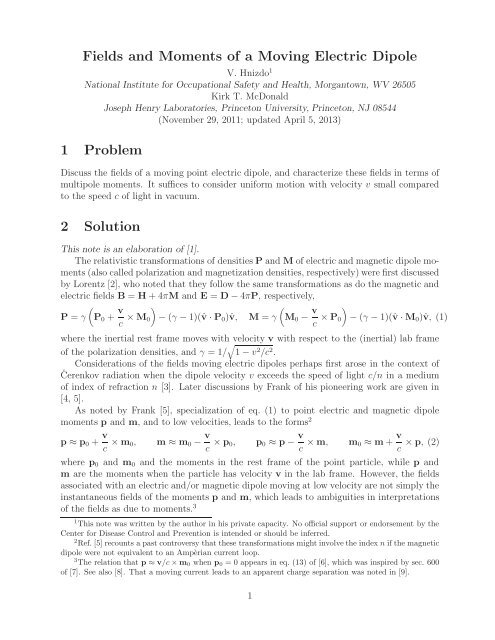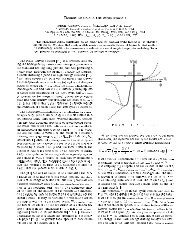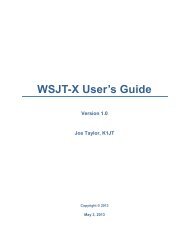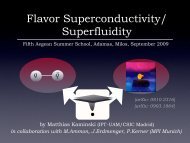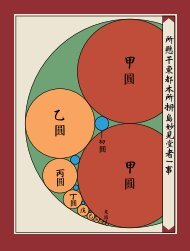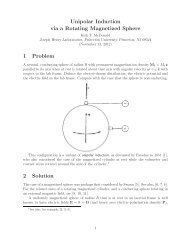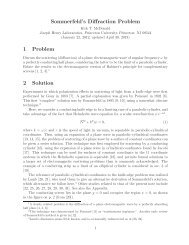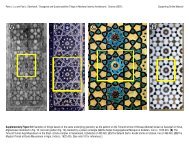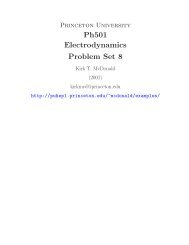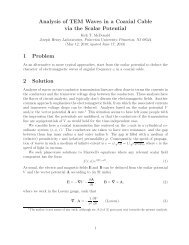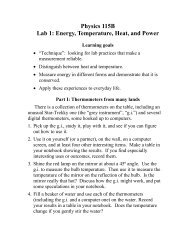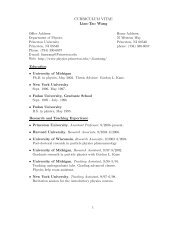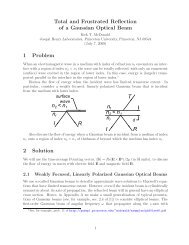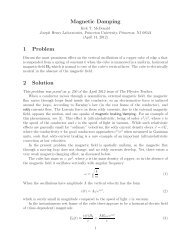Fields and Moments of a Moving Electric Dipole - Princeton University
Fields and Moments of a Moving Electric Dipole - Princeton University
Fields and Moments of a Moving Electric Dipole - Princeton University
Create successful ePaper yourself
Turn your PDF publications into a flip-book with our unique Google optimized e-Paper software.
<strong>Fields</strong> <strong>and</strong> <strong>Moments</strong> <strong>of</strong> a <strong>Moving</strong> <strong>Electric</strong> <strong>Dipole</strong><br />
V. Hnizdo 1<br />
National Institute for Occupational Safety <strong>and</strong> Health, Morgantown, WV 26505<br />
Kirk T. McDonald<br />
Joseph Henry Laboratories, <strong>Princeton</strong> <strong>University</strong>, <strong>Princeton</strong>, NJ 08544<br />
(November 29, 2011; updated April 5, 2013)<br />
1 Problem<br />
Discuss the fields <strong>of</strong> a moving point electric dipole, <strong>and</strong> characterize these fields in terms <strong>of</strong><br />
multipole moments. It suffices to consider uniform motion with velocity v small compared<br />
to the speed c <strong>of</strong> light in vacuum.<br />
2 Solution<br />
This note is an elaboration <strong>of</strong> [1].<br />
The relativistic transformations <strong>of</strong> densities P <strong>and</strong> M <strong>of</strong> electric <strong>and</strong> magnetic dipole moments<br />
(also called polarization <strong>and</strong> magnetization densities, respectively) were first discussed<br />
by Lorentz [2], who noted that they follow the same transformations as do the magnetic <strong>and</strong><br />
electric fields B = H +4πM <strong>and</strong> E = D − 4πP, respectively,<br />
P = γ<br />
(<br />
P 0 + v c × M 0<br />
)<br />
− (γ − 1)(ˆv · P 0 )ˆv,<br />
M = γ<br />
(<br />
M 0 − v c × P 0<br />
)<br />
− (γ − 1)(ˆv · M 0 )ˆv, (1)<br />
where the inertial rest frame moves with<br />
√<br />
velocity v with respect to the (inertial) lab frame<br />
<strong>of</strong> the polarization densities, <strong>and</strong> γ =1/ 1 − v 2 /c 2 .<br />
Considerations <strong>of</strong> the fields moving electric dipoles perhaps first arose in the context <strong>of</strong><br />
Čerenkov radiation when the dipole velocity v exceeds the speed <strong>of</strong> light c/n in a medium<br />
<strong>of</strong> index <strong>of</strong> refraction n [3]. Later discussions by Frank <strong>of</strong> his pioneering work are given in<br />
[4, 5].<br />
As noted by Frank [5], specialization <strong>of</strong> eq. (1) to point electric <strong>and</strong> magnetic dipole<br />
moments p <strong>and</strong> m, <strong>and</strong> to low velocities, leads to the forms 2<br />
p ≈ p 0 + v c × m 0, m ≈ m 0 − v c × p 0, p 0 ≈ p − v c × m, m 0 ≈ m + v c<br />
× p, (2)<br />
where p 0 <strong>and</strong> m 0 <strong>and</strong> the moments in the rest frame <strong>of</strong> the point particle, while p <strong>and</strong><br />
m are the moments when the particle has velocity v in the lab frame. However, the fields<br />
associated with an electric <strong>and</strong>/or magnetic dipole moving at low velocity are not simply the<br />
instantaneous fields <strong>of</strong> the moments p <strong>and</strong> m, which leads to ambiguities in interpretations<br />
<strong>of</strong> the fields as due to moments. 3<br />
1 This note was written by the author in his private capacity. No <strong>of</strong>ficial support or endorsement by the<br />
Center for Disease Control <strong>and</strong> Prevention is intended or should be inferred.<br />
2 Ref. [5] recounts a past controversy that these transformations might involve the index n if the magnetic<br />
dipole were not equivalent to an Ampèrian current loop.<br />
3 The relation that p ≈ v/c × m 0 when p 0 = 0 appears in eq. (13) <strong>of</strong> [6], which was inspired by sec. 600<br />
<strong>of</strong> [7]. See also [8]. That a moving current leads to an apparent charge separation was noted in [9].<br />
1
Before deducing the fields, we note a past misunderst<strong>and</strong>ing regarding eq. (2).<br />
2.1 Fisher’s Claim<br />
In sec. III <strong>of</strong> [10] it is claimed that the magnetic moment <strong>of</strong> a point electric dipole p 0 which<br />
moves with velocity v can be calculated according to<br />
m = 1 ∫<br />
r × J dVol = 1 ∫<br />
r × ρ<br />
2c<br />
2c<br />
0 v dVol = − v ∫<br />
2c × ρ 0 r dVol = − v 2c × p 0, (3)<br />
which differs from eq. (2) by a factor <strong>of</strong> 2.<br />
Furthermore, support for this result appears to be given in probs. 6.21, 6.22 <strong>and</strong> 11.27<br />
<strong>of</strong> [11].<br />
However, we should recall that the origin <strong>of</strong> the first equality in (3) is a multipole expansion<br />
<strong>of</strong> the (quasistatic) vector potential <strong>of</strong> a current distribution. See, for example, sec. 5.6<br />
<strong>of</strong> [11]. That form depends on the current density J having zero divergence. In general,<br />
∇ · J = − ∂ρ<br />
∂t , (4)<br />
where ρ is the electric charge density. 4 The charge density <strong>of</strong> a moving electric dipole is time<br />
dependent, such that ∇ · J ≠ 0, <strong>and</strong> we cannot expect the analysis <strong>of</strong> eq. (3) to be valid. 5<br />
2.2 The <strong>Fields</strong> <strong>of</strong> a <strong>Moving</strong> <strong>Electric</strong> <strong>Dipole</strong><br />
The literature on calculations <strong>of</strong> the fields <strong>of</strong> a moving, point electric dipole is very extensive,<br />
including [12, 13, 14, 15, 17, 18, 19, 20, 21, 22, 23, 24, 25, 26, 27, 28, 29]. Most <strong>of</strong> these<br />
works emphasize the radiation fields <strong>of</strong> an ultrarelativistic dipole. Here, we consider only<br />
the low-velocity limit <strong>of</strong> an electric dipole, <strong>of</strong> strength p 0 initsrestframe,thatisatthe<br />
origin at time t =0withvelocityv. We work in the quasistatic approximation, in which<br />
the potentials are the same in the Coulomb <strong>and</strong> Lorenz gauges.<br />
2.2.1 Multipole Expansions <strong>of</strong> the Potentials<br />
Following the spirit <strong>of</strong> [10], <strong>and</strong> secs. 4.1 <strong>and</strong> 5.6 <strong>of</strong> [11], we consider multipole expansions<br />
<strong>of</strong> the scalar potential V <strong>and</strong> the vector potential A at time t = 0, when the moving electric<br />
dipole is that the origin. Then, the (quasistatic) scalar potential is<br />
V (r,t=0)= p 0 · r<br />
, (5)<br />
r 3<br />
as the charge distribution has only a dipole moment at this time. The (quasistatic) vector<br />
potential has the expansion<br />
A i (r,t=0) = 1 cr<br />
= v ∫<br />
cr<br />
∫<br />
J i (r ′ ,t=0)dVol ′ + r ∫<br />
cr · 3 ∫<br />
ρ 0 (r ′ ,t=0)dVol ′ + v ir<br />
cr 3 ·<br />
r ′ J i (r ′ ,t=0)dVol ′ + ···<br />
r ′ ρ 0 (r ′ ,t=0)dVol ′ + ···<br />
= v ir · p 0<br />
cr 3 , (6)<br />
4 For moving media, ∇ · J = −∂ρ/∂t − (v · ∇)ρ = −dρ/dt.<br />
5 Thanks to Grigory Vekstein for pointing this out.<br />
2
where ρ 0 is the electric charge distribution <strong>of</strong> the electric dipole in its rest frame, ∫ ρ 0 (r) dVol =<br />
0, ∫ ρ 0 (r) r dVol = p 0 ,<strong>and</strong>J = ρ 0 v is the current density <strong>of</strong> the moving electric dipole in the<br />
lab frame. It is perhaps not evident that all higher-order terms vanish in eq. (6), but this<br />
will be confirmed in sec. 2.2.2. Then,<br />
A(r,t=0)= (p (<br />
0 · r)v<br />
= − v )<br />
cr 3 c × p 0 × r r + (r · v)p 0<br />
≡ A 3 cr 3 m + A p , (7)<br />
where<br />
A m = m × r = (p 0 · r)v − (r · v)p 0<br />
with m = − v r 3 cr 3 c × p 0, (8)<br />
which is the vector potential expected from eq. (2) for a moving electric dipole moment (with<br />
no intrinsic magnetic moment), <strong>and</strong><br />
A p = (r · v)p 0<br />
. (9)<br />
cr 3<br />
It is something <strong>of</strong> a convention to say that A m is the vector potential <strong>of</strong> the magnetic<br />
moment <strong>of</strong> the moving electric dipole in that the term A p is also a vector potential with<br />
1/r 2 dependence as associated with dipole potentials. The decomposition A = A m + A p<br />
is <strong>of</strong> possible mathematical convenience but has no well-defined physical significance. For<br />
example, we could also write<br />
where<br />
A = (p 0 · r)v<br />
cr 3 = (p 0 · r)v − (r · v)p 0<br />
2cr 3 + (p 0 · r)v +(r · v)p 0<br />
2cr 3 = A a + A s , (10)<br />
A a = (p 0 · r)v − (r · v)p 0<br />
= 1 2cr 3 2 A m, A s = (p 0 · r)v +(r · v)p 0<br />
, (11)<br />
2cr 3<br />
are the antisymmetric <strong>and</strong> symmetric combinations <strong>of</strong> the terms (p 0 · r)v/2cr 3 <strong>and</strong><br />
(r · v)p 0 /2cr 3 . The decomposition (10) is advocated in probs. 6.21 <strong>and</strong> 6.22 <strong>of</strong> [11], but<br />
should not be construed as implying that the magnetic moment <strong>of</strong> the moving electric dipole<br />
is A m /2, just as the decomposition (7) does not imply that the magnetic moment <strong>of</strong> the<br />
moving electric dipole is A m . 6<br />
It would seem most correct simply to say that 1/r 2 term in the vector potential <strong>of</strong> the<br />
moving electric dipole is (p 0 · r)v/cr 3 without supposing this to be the sum <strong>of</strong> two effects <strong>of</strong><br />
different physical character. Nonetheless, we can be led to the decompositions (7) <strong>and</strong> (10)<br />
by other arguments, each compelling in its way, as considered in secs. 2.2.3 <strong>and</strong> 2.2.4.<br />
2.2.2 <strong>Fields</strong> <strong>and</strong> Potentials via Lorentz Transformations<br />
Before going further, it is useful to note the most direct method <strong>of</strong> obtaining the potentials<br />
<strong>and</strong> fields <strong>of</strong> a moving electric dipole is via a Lorentz transformation from its rest frame,<br />
which has velocity v with v ≪ c with respect to the lab frame.<br />
6 That Jackson was aware <strong>of</strong> both decompositions (7) <strong>and</strong> (10) is indicated in a letter <strong>of</strong> Mar. 20, 1990 on<br />
this theme [30], <strong>and</strong> somewhat indirectly in prob. 11.28 <strong>of</strong> [11]. V.H. thanks J.D.J. for a copy <strong>of</strong> this letter.<br />
3
The potentials in the rest frame <strong>of</strong> the electric dipole, assumed to be at the origin, are<br />
V ⋆ = p 0 · r ⋆<br />
, A ⋆ =0, (12)<br />
r ⋆3<br />
where quantities in the rest frame are denoted with the superscript ⋆ . The Lorentz transformation<br />
<strong>of</strong> the<br />
√<br />
4-vectors (ct, r) <strong>and</strong>(V,A) to the lab frame at time t =0yield,forv ≪ c,<br />
where γ =1/ 1 − v 2 /c 2 ≈ 1,<br />
r ⋆ ‖ = γ(r ‖ − vt) ≈ r ‖ , r ⋆ ⊥ = r ⊥ , i.e., r ⋆ ≈ r, (13)<br />
V = γ(V ⋆ + A ⋆ · v/c) ≈ V ⋆ = p 0 · r ⋆<br />
≈ p 0 · r<br />
,<br />
r ⋆3 r 3 (14)<br />
A = γ(A ⋆ + V ⋆ v/c) ≈ (p 0 · r)v<br />
.<br />
cr 3 (15)<br />
Hence, the multipole expansion (7) <strong>of</strong> the vector potential A at order 1/r 2 is actually the<br />
“exact” result in the low-velocity approximation.<br />
While the fields E <strong>and</strong> B can now be calculated from the potentials according to<br />
E = −∇V − 1 ∂A<br />
, B = ∇ × A, (16)<br />
c ∂t<br />
it is more straightforward to deduce the fields E <strong>and</strong> B as the Lorentz transforms <strong>of</strong> the<br />
fields in the rest frame <strong>of</strong> the electric dipole,<br />
E ⋆ = 3(p 0 · r ⋆ )r ⋆<br />
r ⋆5 − p 0<br />
r − 4π ⋆3 3 p 0δ 3 r ⋆ , B ⋆ =0. (17)<br />
Then, 7 at time t =0whenr ⋆ ≈ r,<br />
E = γ<br />
(E ⋆ − v )<br />
c × B⋆ − (γ − 1)(E ⋆ · ˆv)ˆv ≈ E ⋆ = 3(p 0 · r)r<br />
− p 0<br />
r 5 r − 4π 3 3 p 0δ 3 r, (18)<br />
B = γ<br />
(B ⋆ + v )<br />
c × E⋆ − (γ − 1)(B ⋆ · ˆv)ˆv ≈ v c × E⋆ ≈ v c × E<br />
= v (<br />
c × 3(p0 · r)r<br />
− p 0<br />
r 5 r − 4π )<br />
3 3 p 0δ 3 r ≡ B m + B p ≡ B a + B s , (19)<br />
where the partial fields B m , B p , B a <strong>and</strong> B s will be displayed in secs. 2.2.3 <strong>and</strong> 2.2.4.<br />
2.2.3 Potentials Deduced from Lab-Frame Charge <strong>and</strong> Current Densities<br />
In its rest-frame the point electric dipole p 0 (located at the origin) has polarization density<br />
The associated charge density is<br />
7 See, for example, sec. 11.10 <strong>of</strong> [11].<br />
P ⋆ = p 0 δ 3 r ⋆ . (20)<br />
ρ ⋆ = −∇ ⋆ · P ⋆ = −p 0 · ∇ ⋆ δ 3 r ⋆ . (21)<br />
4
In the lab frame the charge density is<br />
where the lab-frame polarization density is<br />
ρ = γρ ⋆ ≈ ρ ⋆ ≈−p 0 · ∇δ 3 r = −∇ · P, (22)<br />
P = p 0 δ 3 r, (23)<br />
at the instant when the dipole is at the origin, noting that r ≈ r ⋆ <strong>and</strong> ∇ ⋆ = ∇ in the<br />
low-velocity approximation. 8<br />
When the dipole is moving with a velocity v in the lab frame it has current density<br />
J = γρ ⋆ v ≈ ρ ⋆ v = −v(p 0 · ∇)δ 3 r<br />
= −(v · ∇)p 0 δ 3 (r) − v(∇ · p 0 δ 3 r)+(v · ∇)p 0 δ 3 r<br />
= −(v · ∇)p 0 δ 3 r − ∇ × (v × p 0 δ 3 r)<br />
≡ J p + J m , (24)<br />
noting that the operator ∇ does not act on the constant vectors p 0 <strong>and</strong> v. The current<br />
density J p can be thought <strong>of</strong> as an “electric-polarization current,”<br />
J p = −(v · ∇)p 0 δ 3 r ≡−(v · ∇)P = − dP<br />
dt . (25)<br />
Likewise, the current density J m can be thought <strong>of</strong> as a “magnetic-polarization current,”<br />
J m = −∇ × (v × p 0 δ 3 r)=c∇ × m δ 3 r ≡ c∇ × M, (26)<br />
using the convention that m = −v/c × p 0 <strong>of</strong> eq. (2), <strong>and</strong><br />
M = m δ 3 r. (27)<br />
Then the sum <strong>of</strong> the polarization currents (25) <strong>and</strong> (26) equals the “convection” current<br />
(24).<br />
The (quasistatic) vector potentials associated with the polarization currents (25) <strong>and</strong><br />
(26) when the electric dipole is at the origin in the lab frame are<br />
A p (r) = 1 ∫ Jp (r ′ )<br />
c |r − r ′ | dVol′ = − 1 ∫ (v · ∇ ′ )p 0 δ 3 r ′<br />
c |r − r ′ |<br />
= p ∫<br />
0 [v · (r − r ′ )] δ 3 r ′<br />
c<br />
as previously found in eq. (9), <strong>and</strong><br />
dVol ′ = − p 0<br />
c<br />
∫ (v · ∇ ′ ) δ 3 r ′<br />
dVol ′<br />
|r − r ′ |<br />
|r − r ′ | 3 dVol ′ = (r · v)p 0<br />
cr 3 , (28)<br />
A m (r) = 1 ∫ Jm (r ′ ∫<br />
) ∇ ′ × m δ 3 r ′<br />
∫ ∇<br />
c |r − r ′ | dVol′ =<br />
dVol ′ ′ δ 3 r ′<br />
= −m ×<br />
|r − r ′ |<br />
|r − r ′ | dVol′ (29)<br />
∫ (r − r ′ ) δ 3 r ′<br />
= m ×<br />
|r − r ′ | 3 dVol ′ = m × r = − (v × p 0) × r<br />
= (p 0 · r)v − (r · v)p 0<br />
,<br />
r 3<br />
cr 3 cr 3<br />
8 The electric field D = E +4πP has zero divergence, ∇ · D = ∇ · E +4π∇ · P =4πρ +4π∇ · P =0,in<br />
view <strong>of</strong> eq. (22).<br />
5
as previously found in eq. (8).<br />
The magnetic field (19) can now be written as<br />
where<br />
<strong>and</strong><br />
B = v (<br />
c × 3(p0 · r)r<br />
− p )<br />
0<br />
= B<br />
r 5 r 3 m + B p . (30)<br />
B m =2B a = ∇ × A m = −∇ × (v × p 0) × r<br />
cr 3<br />
= − v × p 0<br />
cr 3<br />
= − 3v × p 0<br />
cr 3<br />
(<br />
∇ · r + r ∇ · v × p )<br />
0<br />
− (r · ∇) v × p 0<br />
+<br />
cr 3 cr 3<br />
− 3[r · (v × p 0)]r<br />
+ 3v × p 0<br />
+ v × p 0<br />
cr 5 cr 3 cr 3<br />
= 3[(−v/c × p 0) · r]r<br />
− −v/c × p 0<br />
r 5 r 3<br />
= ∇ × (p 0 · r)v − (r · v)p 0<br />
cr 3<br />
=<br />
3(m · r)]r<br />
r 5 − m r 3<br />
( v × p0<br />
cr 3<br />
)<br />
· ∇ r<br />
= (p 0 · r)∇ × v<br />
cr − v<br />
3 cr × ∇(p 3 0 · r) − (v · r)∇ × p 0<br />
cr + p 0<br />
× ∇(v · r)<br />
3 cr3 = − 3(p 0 · r)r × v<br />
− v × p 0<br />
+ 3(v · r)r × p 0<br />
+ p 0 × v<br />
( cr 5 cr 3 cr 5 cr 3<br />
3(p0 · r)r<br />
= v ×<br />
− p ) (<br />
0<br />
3(v · r)r<br />
− p<br />
cr 5 cr 3 0 × − v )<br />
cr 5 cr 3<br />
= v × 3(p 0 · r)r<br />
− 2v × p 0 3(v · r)r<br />
− p<br />
cr 5 cr 3 0 × , (31)<br />
cr 5<br />
B p = ∇ × A p = ∇ × (r · v)p 0<br />
=(r · v)∇ × p 0<br />
cr 3 cr + ∇(r · v) × p 0<br />
3 cr 3<br />
= −3(r · v)r × p 0<br />
cr + v × p (<br />
0 3(r · v)r<br />
5 cr = p 3 0 × − v )<br />
cr 5 cr 3<br />
= v × p 0<br />
cr + p 3(r · v)r<br />
3 0 × . (32)<br />
cr 5<br />
The consistency <strong>of</strong> this decomposition tends to reinforce the identification <strong>of</strong> eq. (26) as<br />
“the” magnetic moment <strong>of</strong> the moving electric dipole, even though the quantities A p <strong>and</strong><br />
B p also have the 1/r 2 <strong>and</strong> 1/r 3 dependence, respectively, expected for dipole potentials <strong>and</strong><br />
fields. However, alternative decompositions <strong>of</strong> the electric <strong>and</strong> magnetic lead to different<br />
interpretations. One such decomposition is considered in the following section.<br />
2.2.4 Jackson’s Argument<br />
The preceding analyses have assumed for simplicity that the electric dipole is at the origin.<br />
Problems 6.21 <strong>and</strong> 6.22 <strong>of</strong> [11] encourage us to consider the situation when the electric dipole<br />
is not at the origin.<br />
6
If the dipole is at position r 0 , most <strong>of</strong> the preceding results still hold with the substitutions<br />
r → r−r 0 <strong>and</strong> r →|r − r 0 |. However, the multipole moments <strong>of</strong> charge <strong>and</strong> current densities<br />
depend on the choice <strong>of</strong> origin.<br />
The total electric charge, Q = ∫ ρdVol is, <strong>of</strong> course, independent <strong>of</strong> the choice <strong>of</strong> origin.<br />
The electric dipole moment p = ∫ ρ r dVol is independent <strong>of</strong> the choice <strong>of</strong> origin if the total<br />
charge Q is zero (as for an electric dipole moment). Hence, the electric dipole moment <strong>of</strong><br />
a dipole charge distribution is independent <strong>of</strong> the choice <strong>of</strong> origin. However, the electric<br />
quadrupole moment <strong>of</strong> a dipole charge distribution depends on the choice <strong>of</strong> origin.<br />
The magnetic moment <strong>of</strong> a current density that obeys ∇ · J = 0 is independent <strong>of</strong> the<br />
choice <strong>of</strong> origin. In such cases ∫ J dvol = 0, <strong>and</strong> we can write<br />
m = 1 ∫<br />
r × J dVol → 1 ∫<br />
(r − r 0 ) × J dVol = m + r ∫<br />
0<br />
c<br />
c<br />
c × J dVol = m. (33)<br />
In the present example <strong>of</strong> a moving electric dipole the current density has nonzero divergence,<br />
<strong>and</strong> the magnetic dipole moment (<strong>and</strong> higher magnetic moments) depend on the<br />
choice <strong>of</strong> origin. This reinforces the sense <strong>of</strong> previous sections that it is difficult to identify<br />
“the” magnetic moment <strong>of</strong> a moving electric dipole.<br />
Turning to the argument implied in probs. 6.21 <strong>and</strong> 6.22 <strong>of</strong> [11], it is suggested that<br />
the vector potential (15) be rewritten in the form (10) as the sum <strong>of</strong> antisymmetric <strong>and</strong><br />
symmetric terms. The motivation here is not obvious in quasistatic examples, but this<br />
technique is <strong>of</strong> use when considering a Taylor expansion <strong>of</strong> the retarded vector potential <strong>of</strong> a<br />
time-harmonic current distribution J(r,t)=J(r) e −iωt , at distances far from these currents,<br />
A(r,t) = 1 ∫<br />
c<br />
≈<br />
≈<br />
ei(kr−ωt)<br />
cr<br />
ei(kr−ωt)<br />
cr<br />
J(r ′ ,t ′ = t − R/c))<br />
R<br />
∫<br />
J(r ′ ) e −ik ˆr·r′ dVol ′<br />
(∫<br />
∫<br />
J(r ′ ) dVol ′ − ik<br />
dVol ′ ≈ e−iωt<br />
cr<br />
∫<br />
J(r ′ ) e ikR dVol ′<br />
)<br />
J(r ′ )(ˆr · r ′ ) dVol ′ + ··· , (34)<br />
where R = |r − r ′ |≈r − ˆr · r ′ . As is well known (see, for example, secs. 9.2-3 <strong>of</strong> [11]), the<br />
first term corresponds to the vector potential <strong>of</strong> electric dipole radiation, <strong>and</strong> the second<br />
term is the sum <strong>of</strong> the vector potentials <strong>of</strong> magnetic dipole radiation <strong>and</strong> electric quadrupole<br />
radiation. The separation <strong>of</strong> the second term into the two types <strong>of</strong> radiation is accomplished<br />
by considering its symmetric <strong>and</strong> antisymmetric parts,<br />
J(r ′ )(ˆr · r ′ ) = (ˆr · r′ )J(r ′ ) − (ˆr · J(r ′ ))r ′<br />
2<br />
+ (ˆr · r′ )J ′ +(ˆr · J(r ′ ))r ′<br />
2<br />
= (r′ × J(r ′ )) × ˆr<br />
2<br />
= c M(r ′ ) × ˆr + (ˆr · r′ )J(r ′ )+(ˆr · J(r ′ ))r ′<br />
+ (ˆr · r′ )J(r ′ )+(ˆr · J(r ′ ))r ′<br />
2<br />
2<br />
, (35)<br />
where M(r) =r × J(r)/2c is the magnetization density associated with current density J.<br />
The identification <strong>of</strong> r × J/2c as a magnetization density seems justified if J has zero<br />
divergence, which is not the case, in general, in radiation problems. It is noteworthy that [31]<br />
7
(sec. 71) discusses both magnetic moments <strong>and</strong> radiation for a collection <strong>of</strong> point charges,<br />
rather than for a current density J, which deftly avoids the present ambiguities.<br />
For completeness, we record that the magnetic field associated with the symmetric part,<br />
A s , <strong>of</strong> the vector potential (10) is, at time t = 0 when the moving electric dipole is at the<br />
origin,<br />
B s = ∇ × A s = ∇ × (p 0 · r)v +(r · v)p 0<br />
2cr 3<br />
= (p 0 · r)∇ × v<br />
2cr − v<br />
3 2cr × ∇(p 3 0 · r)+(v · r)∇ × p 0<br />
2cr − p 0<br />
3 2cr<br />
= − 3(p 0 · r)r × v<br />
− v × p 0<br />
− 3(v · r)r × p 0<br />
− p 0 × v<br />
2cr 5 2cr 3 2cr 5 2r 3<br />
= v × 3(p 0 · r)r<br />
2cr 5<br />
+ p 0 ×<br />
3(v · r)r<br />
2cr 5<br />
3<br />
× ∇(v · r)<br />
= −3 r × (v · r)p 0 +(p 0 · r)v<br />
2cr 5 . (36)<br />
When the moving dipole is at the origin the magnetic field varies purely as 1/r 3 ,sothe<br />
fourth Maxwell equation (for points away from the dipole itself),<br />
∇ × B = 1 c<br />
∂E<br />
∂t , (37)<br />
tells us that the electric field must include terms that vary as 1/r 4 , which are associated<br />
with the (time-dependent) electric quadrupole moment. However, eq. (37) should not be<br />
construed as implying that the changing electric quadrupole moment “creates” the magnetic<br />
field.<br />
It is instructive to consider ∇ × B s , for which we note that<br />
∇ × r × (v · r)p 0<br />
= ∇ × (v · ˆr) ˆr × p 0<br />
r 5 r 3<br />
= ∇ 1 r 3 × (v · ˆr) ˆr × p 0 + ∇ × [(v · ˆr) ˆr × p 0]<br />
r 3<br />
= − 3 r (v · ˆr) ˆr × (ˆr × p 0)+ ∇(v · ˆr) × (ˆr × p 0)<br />
+(v · ˆr) ∇ × (ˆr × p 0)<br />
4 r 3 r 3<br />
= − 3 r 4 (v · ˆr)[(p 0 · ˆr) ˆr − p 0 ]+ (v · ∇) ˆr × (ˆr × p 0)<br />
r 3<br />
= 3(v · ˆr)p 0 − 3(v · ˆr)(p 0 · ˆr) ˆr<br />
r 4<br />
+ [v − (v · ˆr) ˆr] × (ˆr × p 0)<br />
+(v · ˆr) p 0 − (p 0 · ˆr) ˆr] − 2p 0<br />
r 4 r 4<br />
= 3(v · ˆr)p 0 − 3(v · ˆr)(p 0 · ˆr) ˆr<br />
r 4<br />
+ (v · p 0) ˆr − (v · ˆr)(p 0 · ˆr) ˆr<br />
r 4<br />
− (v · ˆr)p 0 +(v · ˆr)(p 0 · ˆr) ˆr]<br />
r 4<br />
+(v · ˆr) (p 0 · ∇) ˆr − p 0 (∇ · ˆr)<br />
r 3<br />
= −5(v · ˆr)(p 0 · ˆr) ˆr +(v · p 0 ) ˆr +2(v · ˆr)p 0<br />
r 4 . (38)<br />
8
Using eq. (38) with p 0 <strong>and</strong> v interchanged, we obtain<br />
∇ × r × [(v · r)p 0 +(p 0 · r)v]<br />
r 5<br />
Then, recalling eq. (36), we find that<br />
= −10(v · ˆr)(p 0 · ˆr) ˆr +2(v · p 0 ) ˆr +2(v · ˆr)p 0 +2(p 0 · ˆr)v<br />
r 4 .(39)<br />
∇ × B s = 15(v · ˆr)(p 0 · ˆr) ˆr − 3(v · p 0 ) ˆr − 3(v · ˆr)p 0 − 3(p 0 · ˆr)v<br />
. (40)<br />
cr 4<br />
As noted in prob. 6.21(c) <strong>of</strong> [11], when the moving dipole is at position r 0 = vt its electric<br />
field, eq. (18) with r → r − r 0 , has the multipole expansion with respect to the origin,<br />
E = 3[p 0 · (r − r 0 )](r − r 0 )<br />
|r − r 0 | 5 − p 0<br />
|r − r 0 | 3<br />
= 3(p 0 · ˆr) ˆr − p 0<br />
+ 15(r 0 · ˆr)(p 0 · ˆr) ˆr − 3(r 0 · p 0 ) ˆr − 3(r 0 · ˆr)p 0 − 3(p 0 · ˆr)r 0<br />
+ ···<br />
r 3 r 4<br />
= E dipole + E quadrupole + ···, (41)<br />
for r 0 ≪ r. The electric dipole field E dipole (in contrast to the field E <strong>of</strong> the moving electric<br />
dipole) is constant in time (as is the electric dipole moment p ≈ p 0 ). Thus, 9<br />
∇ × B s = 1 c<br />
∂E quadrupole<br />
∂t<br />
≈ 1 c<br />
∂E<br />
∂t . (42)<br />
This establishes a relation between the partial magnetic field B s <strong>and</strong> the electric quadrupole<br />
field E quadrupole <strong>of</strong> the moving electric dipole, but this should not be interpreted as a cause<strong>and</strong>-effect<br />
relation.<br />
It remains that the magnetic field <strong>of</strong> a moving electric dipole p 0 at order 1/r 3 is not<br />
exactly that <strong>of</strong> the “magnetic moment” −v/c × p 0 , so that it is somewhat delicate to use<br />
the terminology “magnetic moment” in this example.<br />
3 <strong>Moving</strong> Magnetic <strong>Dipole</strong><br />
For completeness, we include a discussion <strong>of</strong> the case <strong>of</strong> a magnetic dipole m 0 that has<br />
velocity v in the lab frame.<br />
The potentials in the rest frame <strong>of</strong> magnetic dipole (where the magnetic moment is m 0 ),<br />
assuming the dipole to be at the origin, are<br />
V ⋆ =0,<br />
A ⋆ = m 0 × r ⋆<br />
r ⋆3 , (43)<br />
9 One can show that ∇ × B a = 0, starting from the next to last form <strong>of</strong> eq. (31) <strong>and</strong> using the identities<br />
(a · ∇) ˆr =[a − (a · ˆr) ˆr]/r <strong>and</strong> (a · ∇)(b · ˆr) =[a · b − (a · ˆr)(b · ˆr)]/r, so that eq. (37) is satisfied for<br />
B = B a + B s .<br />
9
where quantities in the rest frame are denoted with the superscript ⋆ . The Lorentz transformation<br />
<strong>of</strong> the 4-vector (V,A) to the<br />
√<br />
lab frame at time t when the dipole is at position<br />
r 0 = vt yield, for v ≪ c, whereγ =1/ 1 − v 2 /c 2 ≈ 1, <strong>and</strong> r ⋆ ≈ r − r 0 ≡ R, is<br />
V = γ(V ⋆ + A ⋆ · v/c) ≈ m 0 × R · v<br />
= v/c × m 0 · R<br />
, (44)<br />
cR 3<br />
R 3<br />
A = γ(A ⋆ + V ⋆ v/c) ≈ A ⋆ = m 0 × R<br />
. (45)<br />
R 3<br />
These potentials have a crisper interpretation than those <strong>of</strong> eqs. (5) <strong>and</strong> (7) for a moving<br />
electric dipole, in that we can say that the potentials <strong>of</strong> a magnetic dipole which moves with<br />
v ≪ c correspond to magnetic dipole moment m = m 0 <strong>and</strong> electric dipole moment<br />
p = v c × m 0, (46)<br />
with respect to its instantaneous position.<br />
The lab-frame fields E <strong>and</strong> B are the Lorentz transforms <strong>of</strong> the fields in the rest frame<br />
<strong>of</strong> the magnetic dipole,<br />
Then,<br />
E ⋆ =0,<br />
B ⋆ = 3(m 0 · r ⋆ )r ⋆<br />
− m 0<br />
. (47)<br />
r ⋆5 r⋆3 E ≈ − v c × B⋆ ≈− v (<br />
c × B = −v c × 3(m0 · R)R<br />
− m )<br />
0<br />
, (48)<br />
R 5 R 3<br />
B ≈ B ⋆ = 3(m 0 · R)R<br />
− m 0<br />
R 5 R . (49)<br />
3<br />
The electric field can also be written as<br />
E = E p + E m , (50)<br />
with<br />
<strong>and</strong> 10<br />
E p = −∇V =<br />
E m = − 1 c<br />
3(p · R)R<br />
R 5<br />
− p R 3 = 3(v/c × m 0 · R)R<br />
R 5 − v/c × m 0<br />
R 3 , (51)<br />
(<br />
∂A<br />
∂t = −1 ∂ m 0 × R<br />
3(v · R)R<br />
= −m<br />
c ∂t R 3 0 ×<br />
− v )<br />
, (52)<br />
cR 5 cR 3<br />
where E p <strong>and</strong> E m can also be interpreted as the electric fields associated with the polarization<br />
<strong>and</strong> magnetization densities <strong>of</strong> the moving magnetic dipole, respectively. The fields (48),<br />
(49), (51) <strong>and</strong> (52) are the duals <strong>of</strong> the fields (19), (18), (32) <strong>and</strong> (31), respectively, <strong>of</strong> a<br />
moving electric dipole, <strong>and</strong> suffer from the ambiguity that the electric (magnetic) field <strong>of</strong><br />
10 The form (52) was noted in prob. 12.4 <strong>of</strong> [32] <strong>and</strong> in prob. 11.29 <strong>of</strong> [11].<br />
10
the moving magnetic (electric) dipole is not simply that <strong>of</strong> the electric (magnetic) moment<br />
<strong>of</strong> the moving dipole.<br />
If we decompose the electric field <strong>of</strong> the moving magnetic dipole into antisymmetric <strong>and</strong><br />
symmetric pieces (with respect to interchange <strong>of</strong> symbols m 0 <strong>and</strong> v),<br />
E = E a + E s , (53)<br />
then<br />
<strong>and</strong><br />
E a = E p<br />
2<br />
= 3[(v/c × m 0/2) · r]r<br />
− v/c × m 0/2<br />
r 5 r 3<br />
= − v (<br />
2 × 3(m0 · r)r<br />
− m )<br />
0<br />
+ m (<br />
0 3(v · r)r<br />
cr 5 cr 3 2 × − v<br />
)<br />
,<br />
cr 5 cr 3 (54)<br />
E s = 3r × (v · r)m 0 +(m 0 · r)v<br />
,<br />
2cr 5 (55)<br />
∇ × E a =0, ∇ × E s = − 1 ∂B quadrupole<br />
, (56)<br />
c ∂t<br />
where the magnetic field <strong>of</strong> the moving magnetic dipole at r 0 canbeexp<strong>and</strong>edforr 0 ≪ r as<br />
B = 3[m 0 · (r − r 0 )](r − r 0 )<br />
|r − r 0 | 5 − m 0<br />
|r − r 0 | 3<br />
= 3(m 0 · ˆr) ˆr − m 0<br />
+ 15(r 0 · ˆr)(m 0 · ˆr) ˆr − 3(r 0 · m 0 ) ˆr − 3(r 0 · ˆr)m 0 − 3(m 0 · ˆr)r 0<br />
+ ···<br />
r 3 r 4<br />
= B dipole + B quadrupole + ···. (57)<br />
The form <strong>of</strong> eq. (54) permits us to consider that the electric dipole moment <strong>of</strong> the moving<br />
magnetic moment is v/c×m 0 /2, rather than that given in eq. (46), so again we must exercise<br />
care in using the term “moment” to characterize a moving intrinsic moment.<br />
For discussion <strong>of</strong> a moving magnetic dipole in an external electric field, see [33].<br />
References<br />
[1] V. Hnizdo, Magnetic dipole moment <strong>of</strong> a moving electric dipole, Am.J.Phys.80, 645<br />
(2012), http://puhep1.princeton.edu/~mcdonald/examples/EM/hnizdo_ajp_80_645_12.pdf<br />
[2] H.A. Lorentz, Alte und Neue Fragen der Physik, Phys.Z.11, 1234 (1910),<br />
http://puhep1.princeton.edu/~mcdonald/examples/EM/lorentz_pz_11_1234_10.pdf<br />
[3] I.M. Frank, Izv. Akad. Nauk USSR, Ser. Fiz. 6, 3 (1942),<br />
http://puhep1.princeton.edu/~mcdonald/examples/EM/frank_ian_6_3_42.pdf<br />
[4] I.M. Frank, Vavilov-Cherenkov radiation for electric <strong>and</strong> magnetic multipoles,Sov.Phys.<br />
Usph. 27, 772 (1984),<br />
http://puhep1.princeton.edu/~mcdonald/examples/EM/frank_spu_27_772_84.pdf<br />
11
[5] I.M. Frank, On the moments <strong>of</strong> a magnetic dipole moving in a medium, Sov.Phys.<br />
Usph. 32, 456 (1989),<br />
http://puhep1.princeton.edu/~mcdonald/examples/EM/frank_spu_32_456_89.pdf<br />
[6] S.J. Barnett, <strong>Electric</strong> <strong>Fields</strong> due to the Motion <strong>of</strong> Constant Electromagnetic Systems,<br />
Phil. Mag. 44, 1112 (1922),<br />
http://puhep1.princeton.edu/~mcdonald/examples/EM/barnett_pm_44_1112_22.pdf<br />
[7] J.C. Maxwell, A Treatise on <strong>Electric</strong>ity <strong>and</strong> Magnetism, 3rd ed./ (Clarendon Press,<br />
1892), http://puhep1.princeton.edu/~mcdonald/examples/EM/maxwell_treatise_v2_92.pdf<br />
[8] W.G.F. Swann, Unipolar Induction, Phys.Rev.15, 365 (1920),<br />
http://puhep1.princeton.edu/~mcdonald/examples/EM/swann_pr_15_365_20.pdf<br />
[9] E. Budde, Das Clausius’sche Gesetz und die Bewegung der Erde in Raume, Ann. Phys.<br />
10, 553 (1880),<br />
http://puhep1.princeton.edu/~mcdonald/examples/EM/budde_ap_10_553_1880.pdf<br />
[10] G.P. Fisher, The <strong>Electric</strong> <strong>Dipole</strong> Moment <strong>of</strong> a <strong>Moving</strong> Magnetic <strong>Dipole</strong>, Am.J.Phys.<br />
39, 1528 (1971),<br />
http://puhep1.princeton.edu/~mcdonald/examples/EM/fisher_ajp_39_1528_71.pdf<br />
[11] J.D. Jackson, Classical Electrodynamics, 3rd ed. (Wiley, New York, 1999),<br />
http://puhep1.princeton.edu/~mcdonald/examples/EM/jackson_ce3_pages.pdf<br />
[12] J.R. Ellis, The fields <strong>of</strong> an arbitrarily moving dipole, Proc.Camb.Phil.Soc.59, 759<br />
(1963), http://puhep1.princeton.edu/~mcdonald/examples/EM/ellis_pcps_59_759_63.pdf<br />
[13] G.N. Ward, On the integration <strong>of</strong> Maxwell’s equations, <strong>and</strong> charge <strong>and</strong> dipole fields,<br />
Proc. Roy. Soc. London A 279, 562 (1964),<br />
http://puhep1.princeton.edu/~mcdonald/examples/EM/ward_prsla_279_562_64.pdf<br />
[14] G.N. Ward, The electromagnetic fields <strong>of</strong> moving dipoles, Proc. Camb. Phil. Soc. 61,<br />
547 (1965), http://puhep1.princeton.edu/~mcdonald/examples/EM/ward_pcps_61_547_65.pdf<br />
[15] H. Mott, G.B. Hoadley <strong>and</strong> W.R. Daw, The <strong>Fields</strong> <strong>of</strong> a <strong>Moving</strong> <strong>Electric</strong> <strong>Dipole</strong>, Proc.<br />
IEEE 53, 407 (1965),<br />
http://puhep1.princeton.edu/~mcdonald/examples/EM/mott_pieee_53_407_65.pdf<br />
[16] H. Mott, G.B. Hoadley <strong>and</strong> W.R. Daw, The Near <strong>Fields</strong> <strong>of</strong> a <strong>Moving</strong> <strong>Electric</strong> <strong>Dipole</strong>,<br />
Proc. IEEE 53, 1262 (1965),<br />
http://puhep1.princeton.edu/~mcdonald/examples/EM/mott_pieee_53_1262_65.pdf<br />
[17] J.R. Ellis, Electromagnetic <strong>Fields</strong> <strong>of</strong> <strong>Moving</strong> <strong>Dipole</strong>s <strong>and</strong> Multipoles, J.Math.Phys.7,<br />
1185 (1966),<br />
http://puhep1.princeton.edu/~mcdonald/examples/EM/ellis_jmp_7_1185_66.pdf<br />
[18] H. Mott, G.B. Hoadley <strong>and</strong> W.R. Daw, Radiation from the <strong>Moving</strong> <strong>Electric</strong> <strong>Dipole</strong>,<br />
Proc. IEEE 55, 92 (1967),<br />
http://puhep1.princeton.edu/~mcdonald/examples/EM/mott_pieee_55_92_67.pdf<br />
12
[19] H. Mott, G.B. Hoadley <strong>and</strong> W.R. Daw, The <strong>Fields</strong> <strong>of</strong> an <strong>Electric</strong> <strong>Dipole</strong> in Motion, J.<br />
Franklin Inst. 283, 91 (1967),<br />
http://puhep1.princeton.edu/~mcdonald/examples/EM/mott_jfi_283_91_67.pdf<br />
[20] J.J. Monaghan, The Heaviside-Feynman expression for the fields <strong>of</strong> an accelerated<br />
dipole, J.Phys.A1, 112 (1969),<br />
http://puhep1.princeton.edu/~mcdonald/examples/EM/monaghan_jpa_1_112_68.pdf<br />
[21] J.R. Ellis, Force <strong>and</strong> couple exerted on a moving electromagnetic dipole, J.Phys.A3,<br />
251 (1970), http://puhep1.princeton.edu/~mcdonald/examples/EM/ellis_jpa_3_251_70.pdf<br />
[22] J. Heras, Radiation fields <strong>of</strong> a dipole in arbitrary motion, Am.J.Phys.62, 1109 (1984),<br />
http://puhep1.princeton.edu/~mcdonald/examples/EM/heras_ajp_62_1109_94.pdf<br />
[23] D. Schieber, Radiation <strong>of</strong> a Receding <strong>Electric</strong> <strong>Dipole</strong>, Electromagnetics 6, 99 (1986),<br />
http://puhep1.princeton.edu/~mcdonald/examples/EM/shieber_electromagnetics_6_99_86.pdf<br />
[24] J. Heras, New approach to the classical radiation fields <strong>of</strong> moving dipoles, Phys. Lett.<br />
A 237, 343 (1998),<br />
http://puhep1.princeton.edu/~mcdonald/examples/EM/heras_pl_a237_343_98.pdf<br />
[25] J. Heras, Explicit expressions for the electric <strong>and</strong> magnetic fields <strong>of</strong> a moving magnetic<br />
dipole, Phys.Rev.E58, 5047 (1998),<br />
http://puhep1.princeton.edu/~mcdonald/examples/EM/heras_pre_58_5047_98.pdf<br />
[26] G.N. Afanasiev <strong>and</strong> Yu P. Stepanovksy, Electromagnetic <strong>Fields</strong> <strong>of</strong> <strong>Electric</strong>, Magnetic<br />
<strong>and</strong> Toroidal <strong>Dipole</strong>s <strong>Moving</strong> in Medium, Phys. Scripta 61, 704 (2000),<br />
http://puhep1.princeton.edu/~mcdonald/examples/EM/afanasiev_ps_61_704_00.pdf<br />
[27] E.A. Power <strong>and</strong> T. Thurinamach<strong>and</strong>ran, Electromagnetic fields <strong>of</strong> a moving electric<br />
dipole, Proc. Roy. Soc. London A 457, 2757 (2001),<br />
http://puhep1.princeton.edu/~mcdonald/examples/EM/power_prsla_457_2757_01.pdf<br />
[28] E.A. Power <strong>and</strong> T. Thurinamach<strong>and</strong>ran, Radiative Properties <strong>of</strong> a moving electric<br />
dipole, Proc. Roy. Soc. London A 457, 2779 (2001),<br />
http://puhep1.princeton.edu/~mcdonald/examples/EM/power_prsla_457_2779_01.pdf<br />
[29] G.S. Smith, Visualizing special relativity: the field <strong>of</strong> an electric dipole moving at<br />
relativistic speed, Eur.J.Phys.32, 695 (2011),<br />
http://puhep1.princeton.edu/~mcdonald/examples/EM/smith_ejp_32_695_11.pdf<br />
[30] J.D. Jackson, Letter to W.A. Newcomb (Mar. 28, 1990),<br />
http://puhep1.princeton.edu/~mcdonald/examples/EM/jackson_032890.pdf<br />
[31] L.D. L<strong>and</strong>au <strong>and</strong> E.M. Lifshitz, The Classical Theory <strong>of</strong> <strong>Fields</strong>, 4th ed. (Pergamon,<br />
1975), http://puhep1.princeton.edu/~mcdonald/examples/EM/l<strong>and</strong>au_cft_sec71.pdf<br />
[32] E.J. Konopinski, Electromagnetic <strong>Fields</strong> <strong>and</strong> Relativistic Particles (McGraw-Hill, 1981),<br />
http://puhep1.princeton.edu/~mcdonald/examples/EM/konopinski_prob12-3-4_81.pdf<br />
13
[33] K.T. McDonald, Mansuripur’s Paradox (May 2, 2012),<br />
http://puhep1.princeton.edu/~mcdonald/examples/mansuripur.pdf<br />
14


